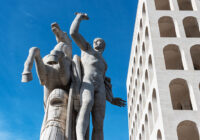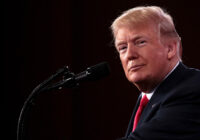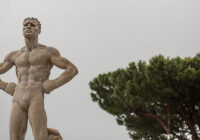Björn Höcke is public enemy number one in present-day Germany. At least that’s what German media suggest. Höcke is a leading exponent of the “völkisch” wing of Alternative for Germany (AfD), the country’s radical right-wing populist party. And Höcke is a fascist. That’s what a German provincial court ruled a couple of months ago. Yet this did not prevent voters in Thuringia, Höcke’s home state, from supporting the AfD in this fall’s regional election.
Höcke is hardly an exceptional case. In early 2018, an article on Medium claimed that US Vice President Mike Pence was the poster child of “Christian fascism,” which, according to that author, was on the rise in America. A few years prior, a prominent left-wing politician attacked Marine Le Pen, the leader of the Front National, asking why France was the only country that wanted to have a “fascist” heading its government. The same charge was brought against Matteo Salvini, the leader of La Lega in Italy, which, ironically, ever since its rise in the 1990s had been vigorously opposed to fascism.
Making Italy Great
Under the circumstances, it might be appropriate to recall what fascism was all about and why equating the likes of Höcke and Salvini with fascism amounts to nothing less than trivializing the ideology. Fascism, at least in its Italian version, was a revolutionary movement, originating on the radical left. Benito Mussolini, fascism’s strongman, started out as a committed Marxist. For a time, he was the editor of Avanti, the Italian Socialist Party newspaper, at a time when socialists were still radical and believed in a global revolution.
Mussolini’s dedication to socialist internationalism abruptly ended with the beginning of World War I. This was hardly surprising. Before the war, European socialists had vigorously opposed militarism. Once hostilities started in 1914, however, virtually all of the socialist parties of the major powers — from Germany to Great Britain — supported their respective countries’ war efforts. The lesson to be drawn from this experience was that international solidarity was a losing proposition. It was nationalism that mobilized and rallied the masses. The nationalist turn meant subordinating class to the national cause. This proved to be a fatal choice, ultimately contributing to the split between socialists/social democrats and communists, which would haunt the socialist movements for decades to come.
In Italy, it led to a third left-wing movement: Mussolini’s National Fascist Party. Etymologically, fascism is derived from two words: the Italian fascio and the Latin fasces. Fascio stands for “bundle” — a group of likeminded individuals closely tied together, similar to Vladimir Lenin’s notion of dedicated revolutionaries. Fasces is a plural word that connotes the bundle of wooden sticks/rods carried by the lictores, who served as bodyguards for ancient Roman magistrates. The fasces symbolized the magistrate’s authority and jurisdiction — i.e., the power of the state.
Fascism is a combination of fascio and fasces — a group of dedicated individuals committed to building a strong “totalitarian” state in the name of the primacy of the nation. Mussolini made it entirely clear that he intended “to destroy the old Italy of decadent liberalism and democracy and give birth to a young, virile, new Italy.” Having abandoned the idea of social revolution, he fully embraced the notion of national revolution aimed at upending the international status quo.
This was behind the notion propagated by the fascists that Italy was a “proletarian nation” — a relatively backward country subordinate to the great European “plutocratic” nations (most notably Great Britain), which prevented Italy from realizing its economic potential and status as a great power. The ensuing conflict was one between the core and periphery. This notion was later adopted by Latin American economists, such as Raul Prebisch, the first secretary-general of the UN Conference on Trade and Development, to explain Latin America’s relative “backwardness.” Thus, it is hardly surprising that prominent Latin American populist leaders such as Juan Perón and, to a limited degree, Jorge Eliécer Gaitán were impressed by fascism, even if the latter considered Mussolini a “ridiculous” figure.
Mussolini’s goal was for Italy to catch up economically and militarily and to turn the country into a major world power. This was reflected in fascist economic policy, centered upon central planning, heavy regulation and protectionism. Given fascism’s ideational roots, it was hardly surprising that it was profoundly hostile to economic individualism, laissez-faire liberalism and capitalism, even if Mussolini was forced to make compromises on the economic front.
In general, fascist economic policy was pure socialism, as was its promotion of social welfare. As Sheri Berman puts it, fascism in the 1930s “spoke to the social and psychological needs of citizens to be protected from the ravages of capitalism at a time when other political actors were offering little help.” Fascism proposed a “national socialist” solution to the hardship experienced by ordinary citizens — a solution that was hardly original. The French Boulangist deputy and prominent writer Maurice Barrès had advanced a similar program as early as the 1890s in an attempt to appeal to working-class voters in his electoral district, the town of Nancy in Lorraine.
Defending the Race
In contemporary parlance, fascism is used as a generic term referring to a range of phenomena, from right-wing extremism to neo-Nazism — both inextricably linked to xenophobia and racism. Historically, the epitome of xenophobia and racism more often than not was anti-Semitism, which was exemplified by the Dreyfus affair in late 19th-century France. Ironically, at least at its beginnings, fascism was anything but anti-Semitic. This was hardly surprising, given Mussolini’s long-time affair with Margherita Sarfatti, who was not only his lover but the individual “who crafted the ideological and philosophical basis of fascism between 1913 and 1919.”
Until the late 1930s, anti-Semitism had no place in fascist doctrine. In fact, Franklin Hugh Adler maintains that until 1938 — when the fascist regime introduced racial legislation — “Italy could only be considered philosemitic.” Italian Jews, a tiny minority of roughly 44,000, were allowed to join the National Fascist Party, and they did so. A number of Jews held prominent positions in the movement, most prominently Guido Jung, who served as minister of finance from 1932 to 1935. Mussolini himself had nothing but disdain for Adolf Hitler’s anti-Semitism. This all changed with the beginning of World War II in 1939 when Mussolini decided to throw in his lot with Hitler. This proved to be a fatal error that ultimately ended with Mussolini’s corpse being hung from a gas station in Milan.
Mussolini believed that the fascist “doctrinal postulates” had “a universal character.” He was even convinced that fascism would “come to fill the present century [i.e., 20th century] with itself even as Liberalism filled the nineteenth century.” In 1932, the party newspaper predicted that within the next 10 years, Europe would be fascist or at least “fascicized.”
Mussolini was not entirely wrong. In the postwar period, central planning, state intervention in the economy, the expansion of the welfare state and Keynesian economics came to rule the day throughout Western Europe. He was wrong, however, in believing that fascism would be able to fundamentally transform human nature, create a new fascist man — hard like granite (the gioventù granitica lampooned in Federico Fellini’s “Amarcord”), domineering and aggressive, prepared to sacrifice himself for the greater good of the nation and thus capable of reviving the glory of the Roman Empire.
Creating the new fascist man meant erasing the image of Italians as “short and dark singing simpletons,” if not worse. (In the US, Italian immigrants were the target of racially-inspired stereotypes, with cartoons depicting them as rats armed with knives and pistols.) In doing so, this would have meant “reconfiguring” Italians as a vital part of the “Aryan race.”
This was the gist of the infamous Manifesto of Race from 1938. It not only sought to establish the Aryan roots of Italians, but also that Italian Jews did not belong to the “Italian race.” Italian Jews, as the manifesto insisted, had never assimilated, and this for good reason: Jews constituted a “non-European element” that was fundamentally different from the Aryan elements that stood at the origins of the Italians. Racism was thus indispensable for the realization of Mussolini’s ludicrous expansionist/imperialist dreams, which ultimately ended in disaster.
Today’s Fascists
Central to fascism is the notion that the individual counts for nothing and the national community for everything. Sacrificing one’s life for the greater good of the national community is the epitome of virtue. This is nothing new. Those familiar with Latin might recall Horace’s famous line, “dulce et decorum est pro patria mori,” which the English poet Wilfred Owen in his well-known eponymous poem dismissed as the “old Lie.”
In contemporary Western consumer societies, the notion that it is somehow “sweet and noble to die for the fatherland” sounds like a rather ludicrous proposition. In our globalized world, the large majority of highly-trained specialists have no home, and the vast majority of ordinary people have better things to do than indulge in nationalist fantasy.
To be sure, the radical right of the 21st century are highly xenophobic and, more often than not, also racist. Yet unlike yesterday’s fascists, today’s radical right-wing leaders — from Marine Le Pen to Matteo Salvini — propagate neither territorial expansion nor anything close to the racial laws of the 1930s, which marked the beginning of a policy of mass murder. There is a distinction between yesterday’s fascism and today’s radical right-wing populism. Calling the likes of Björn Höcke a “fascist” cannot but dilute the meaning of fascism, which is a slippery slope.
The views expressed in this article are the author’s own and do not necessarily reflect Fair Observer’s editorial policy.
Support Fair Observer
We rely on your support for our independence, diversity and quality.
For more than 10 years, Fair Observer has been free, fair and independent. No billionaire owns us, no advertisers control us. We are a reader-supported nonprofit. Unlike many other publications, we keep our content free for readers regardless of where they live or whether they can afford to pay. We have no paywalls and no ads.
In the post-truth era of fake news, echo chambers and filter bubbles, we publish a plurality of perspectives from around the world. Anyone can publish with us, but everyone goes through a rigorous editorial process. So, you get fact-checked, well-reasoned content instead of noise.
We publish 2,500+ voices from 90+ countries. We also conduct education and training programs
on subjects ranging from digital media and journalism to writing and critical thinking. This
doesn’t come cheap. Servers, editors, trainers and web developers cost
money.
Please consider supporting us on a regular basis as a recurring donor or a
sustaining member.
Will you support FO’s journalism?
We rely on your support for our independence, diversity and quality.






